Project Mobile Minuteman: BZHRK American
It should be noted that the Molodets complex was the first in the world serial representative of its class. The very idea of transporting and launching missiles from specially equipped trains appeared in the late fifties. Moreover, the BZHRK idea was not only formed, but also worked through as part of the experiments. The first in the world BZHRK could become the American system with a rocket Minuteman I.
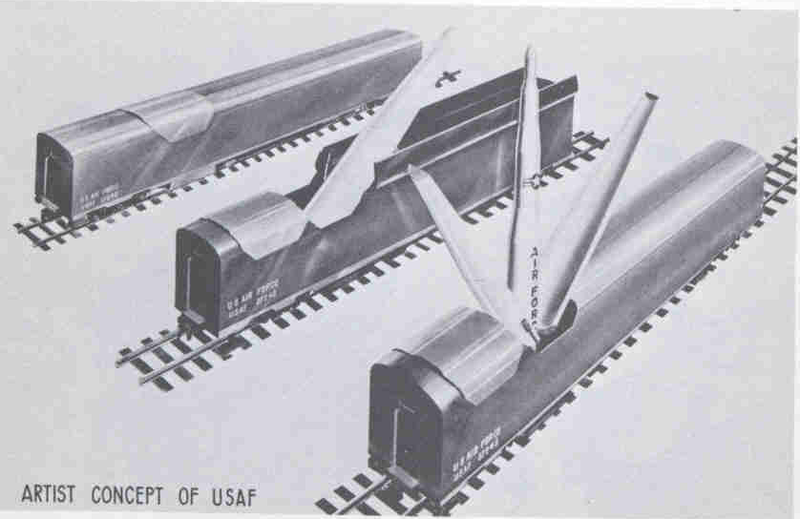
Mobile Minuteman
The first test launch of the intercontinental rocket LGM-30A Minuteman I took place on February 1 of the year 1961. Approximately two years before this event, specialists from the Strategic Command of the US Air Force, the Boeing company and several other related organizations began research on the survivability of strategic missiles. Already in the mid-fifties, it became clear that the mine launchers in the event of a nuclear war would become the target for the first strike, with the result that some of the missiles would be disabled. The loss of part of the "land" missiles could be compensated with the help of submarine armament. Nevertheless, it was necessary to ensure the guaranteed preservation of the largest possible part of land-based missiles.
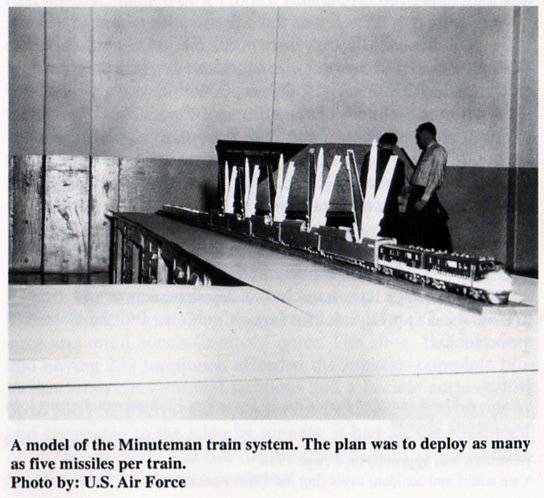
Layout of the Mobile Minuteman complex in a configuration with 5 launchers
During a brainstorming session and the elaboration of several original ideas, American engineers came to the conclusion that there were great prospects for rocket complexes based on trains. At that time, there were several rail networks in the United States with a total length of tens of thousands of miles. This would allow the missile systems to constantly change their position, withdrawing from a possible strike, and also to a certain extent could increase their range by launching missiles from various parts of the country.
Choosing a rocket for a promising complex did not take long. At that time, the development of the LGM-30A rocket continued, which had acceptable dimensions and weight. The total length of this product was 16,4 m, the starting weight was 29,7 t. With such parameters, the rocket with the launch device could be transported in a special railway car. Despite the relatively small size, the rocket had to have a fairly high range characteristics. Three steps with solid-fuel engines promised a range of 9000-9200 km. The combat equipment of the missile was proposed to be performed in the form of a thermonuclear charge. For use with a mobile railway platform, the rocket required a new guidance system, which was supposed to be developed in the near future.
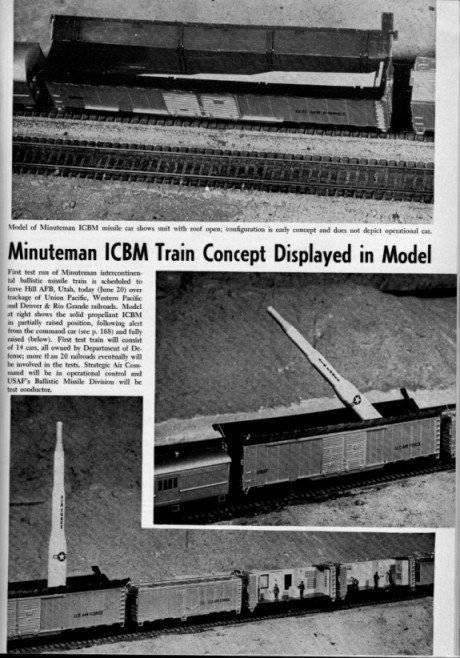
Photo layout BZHRK Mobile Minuteman in the press
12 February 1959 was the year when the official launch of the project, called Mobile Minuteman (Mobile Minuteman), took place. The military, taking into account the geopolitical situation, demanded that all work be carried out as soon as possible. The new "rocket train" was supposed to enter service no later than January 1963. Thus, in less than three years, it was necessary to conduct a full range of research, develop launchers and trains in general, and then test a new weapon system and establish its production.
According to reports, the BZHRK Mobile Minuteman should have included 10 wagons, half of which were used for residential premises and calculation jobs. For example, the command center of the complex was to be equipped with two jobs for officers responsible for launching missiles. For security reasons, the place of payment was proposed to split the armored glass. The remaining cars had to accommodate three launchers with missiles and special equipment.
The preliminary version of the Mobile Minuteman project provided for the use of a wagon with a launcher disguised as a standard refrigerator. According to calculations, the total weight of such a car with a rocket was supposed to reach 127 tons, which required the use of additional wheel sets to reduce the load on the road. Inside the car it was planned to place a set of special equipment that provides for the transportation and launch of a rocket. To dampen vibrations while driving, the car had to carry a system of hydraulic dampers. With the help of hydraulic jacks, it was proposed to lift the rocket into a vertical position before launching and install it on a small launch pad placed right in the car. Due to the lack of a transport and launch container, it was necessary to provide for the protection of the internal units of the car from the rocket engine flame.
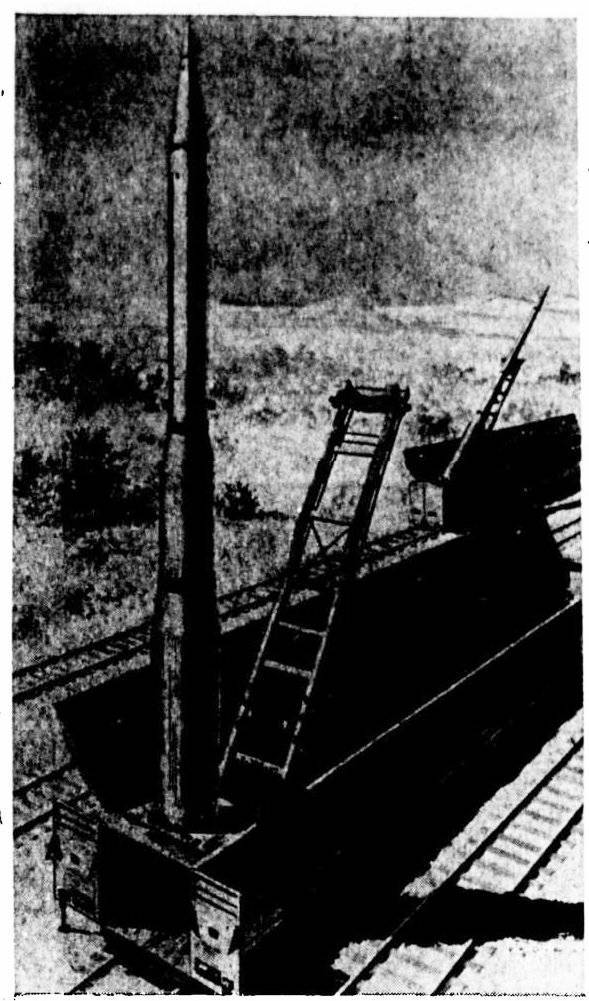
Preparing for launch drawing. Newspaper Prescott Evening Courier
The plans of the US military was a full-scale serial construction of railway missile systems. The 4062 strategic rocket wing (regiment), formed by an order from 1 December 1960, should have operated such a technique. This unit was to be located at Hill Air Base (Ogden, Utah). The 4062-wing consisted of three squadrons, each of which was planned to pass on 10 BZHRK Mobile Minuteman. Thus, at the same time it was possible to deploy to the 90 ICBM "Minuteman-1" in the railway version. According to some reports, over time it was planned to bring their number to 150, leaving 450 missiles of the same type in the mine launchers.
Big Star operation
Creating a promising combat railroad missile system was associated with a number of specific problems and tasks that needed to be resolved as soon as possible. To test the proposed ideas in 1960, the Strategic Command of the Air Force and the Boeing company launched a series of tests called the “Operation Big Star” (according to other data, Bright Star). As part of this work, it was planned to build several prototype trains and conduct their sea trials on US railways.
In total, it was planned to conduct six stages of testing with the use of trains of different composition. In addition, the routes of prototype trains were laid on different railways of the United States. Thus, in a few months it was possible to carry out the full range of necessary research, check the available proposals and make adjustments to the preliminary draft. An interesting fact is that from the operation "Big Star" did not make special secrets. All tested trains traveled around the country without any disguise, and the provincial press constantly reported on the visit of the “rocket train” to a particular city.
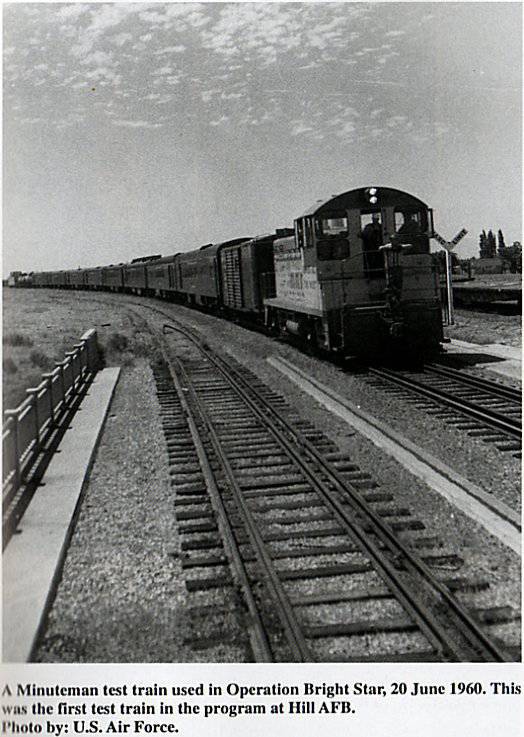
Experienced train on trial, 20 Jun 1960 g.
The first test staff was formed at Hill AFB in mid-June 1960. A train of 14 cars for various purposes, including a car with a prototype launcher, set off on June 21. Until June 27, the train covered about 1100 miles on the railways of the Union Pacific, Western Pacific and Denver & Rio Grande networks.
The second train with a modified composition set off in early July of the same year. This trip lasted about 10 days for which 2300 miles were traveled. The exact route is unknown, but there is information on the composition of the crew of this “rocket train”. The second stage of the trial involved 31 military and 11 civilian specialists.
On July 26, a third test train (13 cars) left the Hill base and included an updated prototype car of the launcher. To check the vibration damping system, the LGM-30A weight and size simulator of the rocket, made of metal and filled with sand, was loaded into the car. In addition, the train picked up a platform with a container in which there was a solid propellant rocket engine. In this way it was planned to check the impact of vibration and other loads on rocket fuel. In two weeks, the third train traveled about 3000 miles along the roads of seven networks. The train crew consisted of 35 military and 13 civilian specialists.
In August, the last test trip to the country's railway network took place. In terms of the duration and composition of the train, the fourth tests were similar to the third. They, like a few days earlier, checked the vibration damping system and the impact of arising loads on the charge of solid fuel, as well as the work of various communication and control systems.
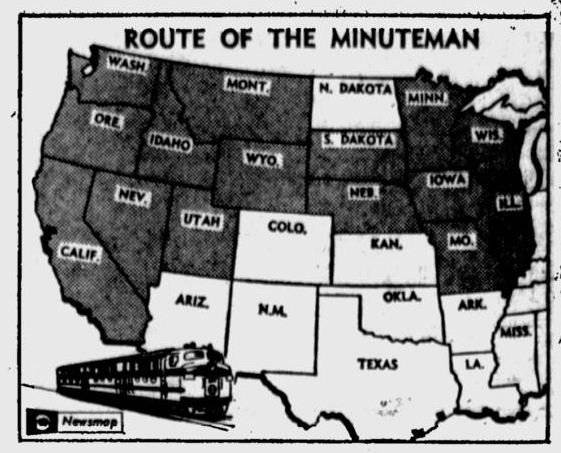
The route of one of the latest test flights. Prescott Evening Courier newspaper layout
27 August 1960, the prototype BZHRK Mobile Minuteman train returned to Hill base. During the four flights, we managed to complete the entire test program, with the result that, instead of carrying out two additional visits, the specialists were able to concentrate on other research and design work.
End of project
13 December 1960 of the year, Boeing completed the assembly of a full-size model of a promising "rocket train". The layout was supposed to show the military and get approval for the construction of a full-fledged prototype with all the necessary systems. Thus, in 1961, the Mobile Minuteman project could go on to the stage of full sea trials and test launches. The technical appearance of the prospective BZHRK underwent some changes by this time in comparison with the earlier versions, but it was based on previous ideas concerning the general architecture of the complex, weapons and application methods.
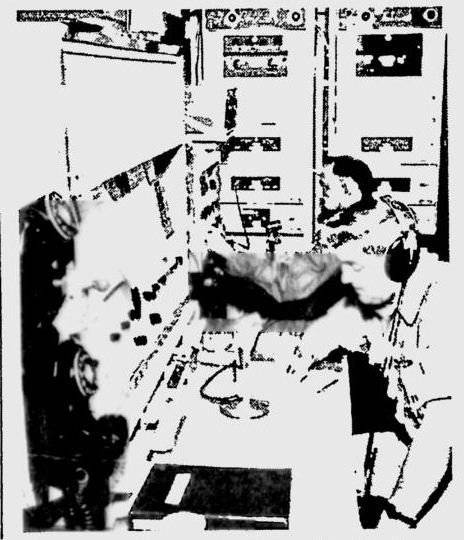
Calculation of the complex at work. Photo of the Spokane Daily Chronicle newspaper
However, already December 14 received an order to suspend all work. During the tests, it became clear that, in the proposed form, the new missile system has both advantages and disadvantages. In addition, the active development of rocket technology and nuclear forces in general affected the course of promising projects. Officially, the reason for stopping the project was its high cost. For almost two years, the Mobile Minuteman project “ate” several tens of millions of dollars, and further work should have led to additional expenses. As a result, the project was considered too expensive and stopped.
The second blow to the development of the American BZHRK was the order of US President John F. Kennedy on March 28 of 1961. In accordance with this document, the strategic nuclear forces were to be strengthened not by a new wing armed with “rocket trains”, but by a subunit with silo-based missiles.
The latest document in the fate of the project "Mobile Minuteman" was the order of the Minister of Defense Robert McNamara. December 7 1961, the head of the military department ordered to finally stop all work on the combat railway missile system with a special version of the LGM-30A rocket Minuteman I. In the future, this weapon used only with mine launchers.
The development of a preliminary draft, testing and subsequent work allowed to establish the positive and negative features of the original proposal. The advantages of the Mobile Minuteman complex include the highest mobility of launchers capable of moving along the many existing railways, and a high probability of survival in the event of a nuclear conflict. In addition, it was considered a plus no need to develop a completely new rocket. As part of the BZHRK was supposed to use a modification of the product LGM-30A with an updated guidance system that can take a missile at the specified target from anywhere in the US.
However, enough and cons. The main one is the high cost of developing and building complexes. It was this flaw that ultimately led to the closure of the project. Great difficulties were associated with preparing the rocket for launch. After reaching the starting position, it was required to begin a complex and lengthy preparation procedure. In particular, it was necessary to accurately determine the coordinates of the train and introduce an updated flight program into the rocket electronics, which seriously hampered the combat work in a real conflict.
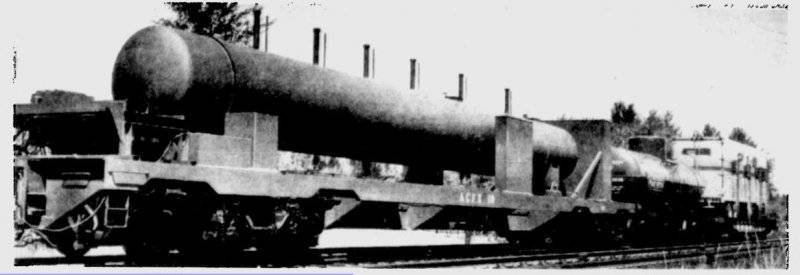
A prototype train with a rocket simulator arrived in Spokane, Washington. Photo of the Spokane Daily Chronicles newspaper
The operation of serial “rocket trains” could be associated with some logistical and legal difficulties. The relatively large weight (127 t) of the car with the launcher imposed certain restrictions on the choice of route, which was required to be made taking into account the state of the railway tracks. In addition, due to the lack of a unified company containing and operating all the country's railways, certain difficulties could arise with the access of BZhRK to some networks or switching from one network to another.
As a result of comparison, the advantages of the promising missile system could not outweigh the existing disadvantages. The military found the BZHRK Mobile Minuteman too expensive and therefore had no advantages over existing mine systems. The project was closed, but the idea was not lost in the archives. In the late sixties, they began to make their BZHRK in the Soviet Union, and in the mid-eighties a second similar project of American design appeared.
Based on:
http://strategic-air-command.com/
http://rocketryforum.com/
http://rbase.new-factoria.ru/
Archives of newspapers The Deseret News, Prescott Evening Courier, Gadsden Times and Spokane Daily Chronicle
Information